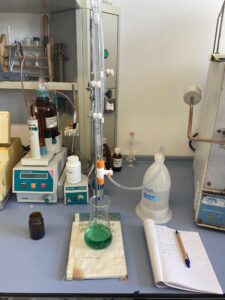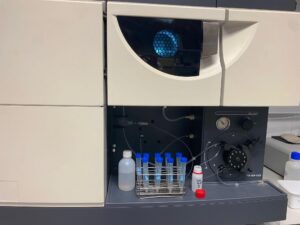SUMMER 2024
Zoe Tobien
During my two month stay in Valencia, Spain, I got assigned to do research on the comparison of almonds from the U.S. (California), Spain (Valencia), and Italy. I ran various tests to determine many aspects about these almonds.
The first aspect would be size, and this was easily measured using a digital caliper. The U.S. almonds on average had the smallest volume, followed by the Valencian almonds, and then the Italian almonds were the largest. This would be visible in the picture (001-Valencia, 002-U.S., 003-Italy). The Spanish and Italian almonds have similar physical appearances, quite flat and a light sandy brown, while the U.S. almonds were more skinny, but with more thickness, and darker brown. The Italian almonds also weighed the heaviest, followed by Spain, and the U.S, correlating to volume.

A second aspect measured was humidity, and all of the almonds were quite similar with the Italian having the least, but all around the 3-4% range, which makes sense as almonds are quite dry with very little moisture. I found the humidity by drying ground up almonds in an oven, then finding the difference between the dried and the original, and finally using a formula to calculate.
Another aspect was the fat content, and again all the almonds were quite comparable; they were all in the 46-48% range. To find the fat content I had to use a Soxhlet machine that, through a series of distillations, isolated the fat so at the end there was only pure almond oil. We then weighed and implemented the collected data into a formula. For protein (nitrogen) content, determined through titrations (shown in the picture) after preparing the almonds by boiling them in a strong acid, the Valencian almonds had the most at 18.8%, U.S. followed at 18.3%, and Italian almonds last with the least percentage of protein at 17.3%. The opposite is true for fiber content where this time the Italian almonds had the most at 17.2%, then the U.S. at 15.5%, and finally the Valencian almonds at 13.6%.

The most notable difference between the almonds was in polyphenol content. Polyphenols are healthy compounds found in plant foods, and in this case the Valencian almonds had a polyphenol content of 147, while Italy followed at 18 and the U.S. at 13. After some discussion with my professor about why this might be, she said that it was likely because the Italian and U.S. almonds had to be shipped and could’ve lost polyphenol content during the time it took to reach Valencia. The polyphenol content was found using the Folin–Ciocâlteu reagent and spectroscopy.
Finally I had the chance to find out the amount of individual elements present in each type of almond using a large spectrometer machine. It was interesting because two different trials had to be done due to some elements being classified as macro or micro. All element levels were comparable between the groups of almonds. For a cool note, and as shown in the picture, the element sodium in the machine glowed slightly orange.

 Onto a more personal note, through this program I was able to introduce myself to research and the world of academia. It has inspired me to pursue some research positions at NC State and keep on exploring if research is for me. Putting research aside, because of this program I did something I was scared to do. Looking back at it, I often think “how did I even bring myself to do that,” but I did this scary thing and I came out the other side better for it. I now have more confidence and have no problem doing things independently. I also gained the sense of how it feels to be “living” in a new country, that out of place feeling that you can’t quite feel just from a vacation. I have developed a new understanding and have a lot more empathy towards those that move out of their own country. I think it has also just reinforced the idea that you can develop a routine and get used to a new sense of normal anywhere, and that it truly does get a bit easier over time.
Onto a more personal note, through this program I was able to introduce myself to research and the world of academia. It has inspired me to pursue some research positions at NC State and keep on exploring if research is for me. Putting research aside, because of this program I did something I was scared to do. Looking back at it, I often think “how did I even bring myself to do that,” but I did this scary thing and I came out the other side better for it. I now have more confidence and have no problem doing things independently. I also gained the sense of how it feels to be “living” in a new country, that out of place feeling that you can’t quite feel just from a vacation. I have developed a new understanding and have a lot more empathy towards those that move out of their own country. I think it has also just reinforced the idea that you can develop a routine and get used to a new sense of normal anywhere, and that it truly does get a bit easier over time.
Research Pack Abroad provides undergraduate students international research experience – working side-by-side with scientists and immersed in another culture. Students are connected with a host international research institution, where they conduct research for at least 2 months during the summer.